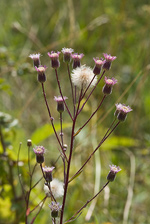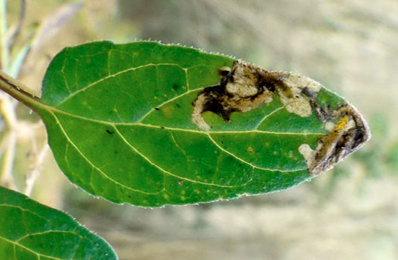|
||||||
|
ERIGERON. Fleabanes. [Asteraceae] |
|
|
Eleven species of Erigeron are recorded in Britain, These include the native Blue Fleabane (E. acer) and Alpine Fleabane (E. borealis). Erigeron acer is treated as Erigeron acris by Stace (2010). Blue Fleabane (E. acer) is protected in Northern Ireland under Schedule 8 of the Wildlife (Northern Ireland) Order, 1985. Seven or eight British miners are recorded on Erigeron. A key to the European miners recorded on Erigeron is provided in Bladmineerders van Europa. |
 Blue Feabane Erigeron acer |
Key for the identification of the known mines of British |
1# > Leaf-miner: Details unknown. |
|
Pegomya depressiventris (Zetterstedt, 1845) [Diptera: Anthomyiidae]. |
1a > Leaf-miner: A distinctive mine primarily above mid-rib, with irregular short lateral offshoots into leaf blade. Pupation external (Spencer, 1972: 51 (fig. 172), 55; Spencer, 1976: 270, 271 (fig. 486)). Branched, whitish, upper-surface corridor; main axis overlying the midrib; side branches overlying the main lateral veins. (In Campanula and Phyteuma the mine is much less branched, sometimes nothing more than a corridor on top of the midrib). Frass in rather long strings. Usually the mines begins as a long and narrow, shallow, tortuous lower-surface corridor that ends upon the midrib but otherwise is not associated with the leaf venation. Often this initial corridor is filled with callus, and then even less conspicuous. Pupation outside the mine. A linear mine on the upper surface, usually following the midrib and showing side branches along the veins. The frass is in strings. |
|
Liriomyza strigata (Meigen, 1830) [Diptera: Agromyzidae]. |
1b > Leaf-miner: Mine linear, whitish, both upper and lower surface. Pupation internal, at the end of the mine with the anterior spiracles projecting through the epidermis (Spencer, 1976: 433). Upper-surface, less often lower-surface corridor. Frass in isolated grains. Pupation within the mine, in a, usually lower-surface, pupal chamber. A long whitish upper surface corridor, which eventually goes lower surface. |
|
Chromatomyia
horticola (Goureau, 1851) [Diptera: Agromyzidae] |
1c > Leaf-miner: A short linear mine in first instar, later producing a circular or oval blotch. Frass is excreted in a black mass prior to pupation; puparium firmly glued with frass within the mine (Spencer, 1976: 306). Large, whitish, upper-surface blotch, preceded by a short corridor that often is overrun later by the developing blotch. The larva hardly produces any frass; the few grains that are present are black and rather coarse. But when the larva is about to pupate, it empties its intestine, which has the effect that the puparium is anchored in the mine by dried frass. The initial gallery by the first instar larva then leads to a whitish blotch. The puparium is fixed to the inside of the mine by an accumulation of frass. |
|
Calycomyza humeralis (von Roser, 1840) [Diptera: Agromyzidae]. |
1d > Leaf-miner: A long, winding leaf-mine on the upper surface of the leaf, with frass widely-spaced in conspicuous black lumps. Pupation internal, at the end of mine (Spencer, 1972b: 28 (fig. 68), 29). Mines on Sonchus and Taraxacum are illustrated in British leafminers and on Solidago in Bladmineerders van Europa. |
|
Ophiomyia maura (Meigen, 1838) [Diptera: Agromyzidae]. |
1e > Leaf-miner: A narrow upper surface linear branching mine without apparent feeding lines. Frass in isolated grains and pearl chains. At least in Erigeron older mines turn reddish-brown. Pupation external (Spencer, 1976: 413). |
|
Phytomyza erigerophila Hering, 1927 [Diptera: Agromyzidae]. |
1f > Leaf-miner: Rather narrow corridor, untidy and sometimes branched, starting from the base of the leaf, in particular the midrib. Sides of the corridor irregularly eaten out, not really parallel. Frass mostly present, and then in a central line. The larva is capable of leaving the mine and start a new one elsewhere. These later mines are much broader, and the frass is scattered irregularly.. |
 Mine of Orthochaetes insignis on Prunella vulgaris Image: © Jean-Yves Baugnée (Bladmineerders van Europa) |
|
|
Orthochaetes insignis (Aube, 1863) [Coleoptera: Curculionidae]. |
| Last updated 04-Jul-2019 Brian Pitkin | ||
